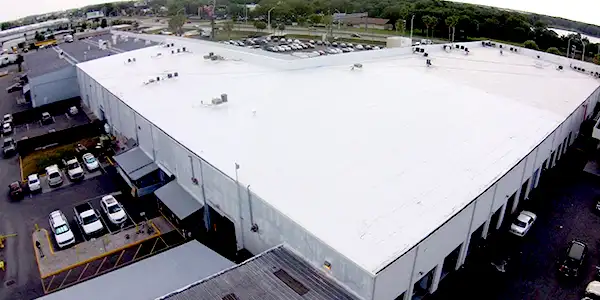#AskCentiMark Series: A guide on understanding R-value and energy studies.

Get ready to take a deep dive into R-value and energy studies for commercial buildings! Familiarizing yourself with the energy use of your facility will provide you with endless benefits. In this interview, our very own industry experts explain how energy studies guide the development of tailored roofing solutions for commercial buildings that optimize cost savings, energy efficiency and a healthier workplace environment.
Two of CentiMark’s roofing professionals are here to give you lots of great insights on R-value and energy studies: Cal Reese, Director of Global Accounts, and Douglas Rebman, Regional Sales Manager! These individuals have worked in various climates with diverse facilities, gaining the knowledge and experience that it takes to help further your understanding on the importance of conducting energy studies for your commercial building.
How are R-value and energy studies tied together in the commercial roofing industry?
Douglas: Both of these are essential to increase energy efficiency, maintain sustainability, extend the life of a roof and drive down heating and cooling expenses. We gather the combined data of R-value and an energy study in order to provide as much information as we can for our clients so they can make an educated decision on how they want to move forward with their roofing decisions.
Can you walk us through the process of conducting an energy study on a commercial building?
Cal: Of course! We take the time to get a deeper understanding of the functionality of the building, along with its roof, when performing evaluations and energy studies on commercial buildings. What are the patterns of their heating and cooling? Do they use gas or electricity within the facility? What is the structure of their roof system? How can the regional climate affect their building?
Douglas: Exactly, evaluating each and every component of the roof is crucial when performing an energy study! Even the color of the commercial roof comes into play. Darker roofs absorb more which helps your building to stay warmer, whereas light-colored roofs reflect more sunlight and heat, assisting in keeping your building cool. When we conduct energy studies and are proposing a new roofing solution we tend to look at the climate to determine the color of the roof, among lots of other aspects.
How do you use the energy study and desired R-values to develop a roofing solution for your customers?
Cal: When developing a roofing solution, we want to evaluate every aspect of what they’re doing inside their building, what their roofing intentions are and the length of the life of the roof that they want. Energy studies and r-value play a huge part in the return on investment on the solutions we provide for our customers. If they are prioritizing energy efficiency within their building, we ensure the materials in the roof system reflect that and fit their goals.
How do energy studies take the local climate and building use into account?
Douglas: We combine these two factors to gather the comprehensive data we need to provide our customers with a deeper understanding of their building. Like I said earlier, climate plays a significant role in influencing insulation and energy efficiency. In colder climates, a building might benefit from a black roof to better retain heat, while in warmer climates, a white roof would be preferred in order to reflect sunlight and reduce cooling costs. However, the primary factor we take into consideration is building use. For facilities that require consistent, cooler temperatures, like cold storage units, the external climate becomes less significant because the r-value remains somewhat consistent in buildings like these, regardless of location. Overall, what the building is being used for is what we prioritize when conducting energy studies.
Can you think of an instance when a facility manager has made changes based on the results of their energy study and how it impacted the cost savings and energy efficiency in their building?
Cal: I spent 10 years working with a company located in Dallas, Texas and they had the same roof for about 20 years. They were manufacturing issues where their employees were feeling fatigued within their facility. During the era when this roof was installed, building codes weren’t enforced as much, so energy studies weren’t conducted back then. Over the years, this resulted in poor R-value and cooling costs. Over time, they saw production going down and employee absence going up due to the excessive heat within the building. Putting a new roof on their building was critical in keeping their business afloat. Essentially, this is when building codes started to evolve and property owners, like this client, started investing in roofs that would benefit them in many different ways such as worker productivity, energy efficiency, cost savings and more.
From overall cost savings to enhanced workplace environments for your building occupants, staying up to date with your commercial building's energy use and R-value is essential for many reasons. We hope that today’s expert panel helped guide you in learning about them! Contact us to schedule a commercial roof evaluation to get a deeper understanding of your roof and how it can impact your business operations. Be sure to keep an eye out for our next #AskCentiMark post for more industry insights!
About our panel:
Cal Reese
Director of Global Accounts
Cal has been in the industry for about 27 years and has worked with energy efficiency-focused clients around the United States for most of those years! From manufacturing to cold storage facilities, he has worked with all types of customers who are looking to make their buildings more energy-efficient!
Douglas Rebman
Regional Sales Manager
Douglas has been with CentiMark for over 30 years and has worked in diverse climates over the course of his career. From working in cold climates like Ohio, to warmer climates like Virginia, his commercial roofing experience within these locations has provided him with a deep understanding of energy studies and how they vary for each client and their building.
When you subscribe to the blog, we will send you an e-mail when there are new updates on the site so you wouldn't miss them.
We use cookies to improve your experience on our website. By clicking "I accept" or continuing to use our site, you consent to the use of cookies unless you have disabled them. Learn more here: Privacy Policy and CCPA.


